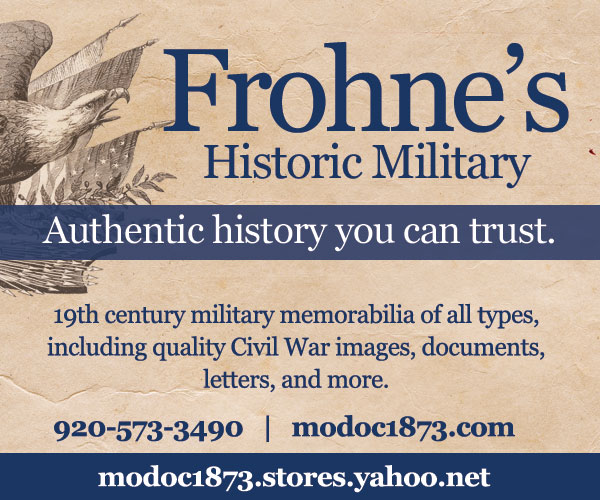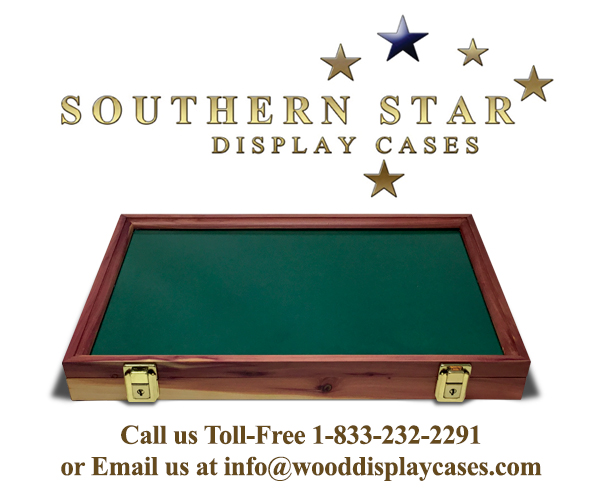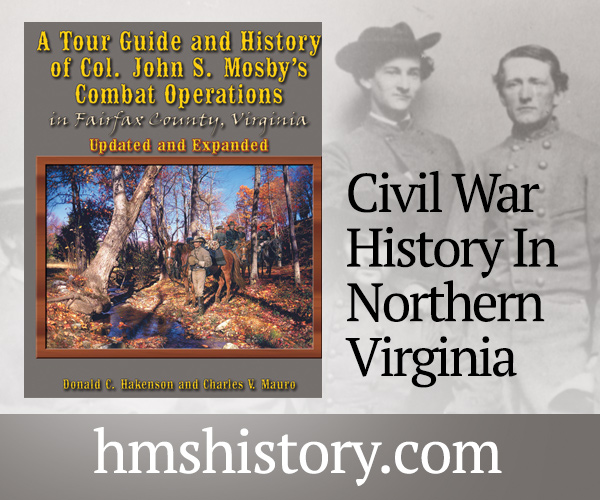The complete issue
Vol. XXIX, No. 5
(40 pages)
Print edition: Visit our store to check availability
Digital edition: Visit JSTOR.org to purchase
Subscribe to MI
Explore the MI Archives: Browse | Advanced search | Tutorial
Inside
Cover image
A sixth-plate ambrotype from the David W. Vaughan collection is a portrait of a Confederate sergeant standing with a large knife and a musket with fixed bayonet.
Table of Contents (p. 1)
Editor’s Desk (p. 2)
The editor thanks subscribers for their patience and understanding for the delay in publication due to “the critical illness of an immediate family member.” He assures readers that the issues scheduled for this year will be published as soon as possible. The editor also notes the passing of two members of the Civil War community: Collector James Stamatelos amassed an impressive selection of photos, some of which appeared in the March/April 1997 issue of MI, and Ed Hahn, a historian, archivist, author and World War II veteran.
Passing in Review (p. 3)
This page is intentionally blank with the exception of a note, “Book Reviews Will Return In The Next Issue Of MI” and an advertisement.
Men of Gettysburg by Brian Boeve (pp. 4-9)
Three wartime soldier portraits are featured in this tribute to the Battle of Gettysburg. They include an unidentified member of the 146th New York Infantry (Garrard’s Tigers), a Zouave regiment that fought on Little Round Top, Corp. Burlington “Burl” Cunningham of the 19th Indiana Infantry, who carried the regiment’s flag into battle and suffered two wounds, and Pvt. Thomas Eubanks of the 7th Wisconsin Infantry, an Iron Brigade regiment that participated in the action in Herbst Woods during the first day of the battle.
Warren’s Field Glasses by Michael J. McAfee (pp. 10-13)
Maj. Gen. Gouverneur K. Warren carried this unique relic with him on the afternoon of July 2, 1863, when he famously acted quickly to move Union troops on his own authority to counter Confederate forces moving on his position on Little Round Top. The field glasses are part of the West Point Museum Collection. The story is illustrated with a photo of the glasses and other images.
Francis H. Abbott, 17th Regiment Virginia Volunteers (pp. 14-15)
An albumen print from the collection of Mahlon Nichols is a portrait of Abbott, who served with Company A of the 17th. He was killed in action at the Battle of Williamsburg, Va., on May 5, 1862, and buried where he fell. This information is included on the back of the print along with a stanza from William Collins’s poem “How Sleep the Brave.”
Thomas and Samuel Livingston’s Civil War by Linda Livingston Kovar (pp. 16-19)
Biographical sketches of Thomas Grove Livingston, a corporal in Company C of the 110th Pennsylvania Infantry, and his younger brother, Samuel Livingston, a private in Company D of the 13th Pennsylvania Cavalry, are illustrated with wartime and postwar portraits. Both brothers survived the war and lived in the 20th century.
Officers of the 10th U.S. Cavalry at Ft. Riley, Kansas, 1867 by Robert Kotchian (pp. 20-21)
A cabinet photograph pictures the white officers of the African American 10th U.S. Cavalry. Numbers printed on top of the image correspond to a list that provides details of the officers, an officer’s wife, and two dogs.
Vignettes from the Collection of Patrick Knierman (pp. 22-24)
A profile of Pvt. Franklin G. Lewis, who served in Company D of the 145th Pennsylvania Infantry, includes detail of his death at the Battle of Fredericksburg. Also profiled is Pvt. Theron Swap, who served in Company H of the 111th Pennsylvania Infantry. He suffered a mortal wound at Culp’s Hill on July 3, 1863, during the third and final day of the Battle of Gettysburg. Swap’s story includes, in addition to his portrait, images of two of his comrades, Corp. Daniel Gibson and Pvt. Isaac Baldwin. A postwar portrait of Swap’s brother is also included. Jacob E. Swap of the 83rd Pennsylvania Infantry received the Medal of Honor for his actions at the 1864 Virginia battles of the Wilderness and Laurel Hill.
The Confederate Soldier (p. 25)
A ninth-plate ambrotype from the Peggy Dillard collection pictures an unknown Confederate soldier “with a brace of evolvers and a gigantic fighting knife.” The image was found in Texas.
Uniforms & History by Michael J. McAfee (pp. 26-27)
In “Charles F. Johnson, 9th Regiment, New York Volunteer Infantry ‘Hawkins’ Zouaves,’” McAfee muses about he acquired the perfect Civil War image on eBay, a perfect condition carte de visite of Johnson posed with his arm in a sing from the effects of a wound suffered in the 1862 Battle of Camden, N.C. The author explains that Daniel Lorello had stolen the image from the New York State Archives and auctioned it on eBay. Lorello, an employee of the Archives, was eventually caught. McAfee was ordered by the Attorney General’s office of New York to return the image, which he did.
Stragglers (pp. 28-37)
A total of 16 images submitted by subscribers are featured, and they are a mix of Civil War and post-war photographs. Identified images include 1st Lt. Charles B. Brockway of the 1st Pennsylvania Light Artillery, Jared Carr of the 85th Indiana Infantry, 1st Sgt. David M. Scott of the 54th Alabama Infantry, Theodore Hoeninghausen of the 16th Michigan Infantry (postwar portrait), Corp. Charles Kimball of the 13th Pennsylvania Reserve Infantry and Veteran Reserve Corps and 2nd Lt. John S. Miller of the 29th Iowa Infantry.
Sutler’s Row (pp. 38-39)
The Last Shot (p. 40)
An albumen print from the collection of John Sickles is captioned, “Determined to fight for his freedom, an unidentified African-American soldier ready for the fray.”
Back Cover
A real-photo postcard from the Chris Nelson collection pictures three individuals dressed as Abraham Lincoln, Lady Liberty and Lt. Gen. Ulysses S. Grant. The trio is flanked by two World War I doughboys.





































